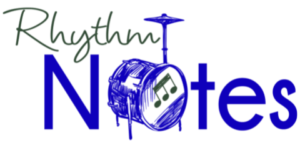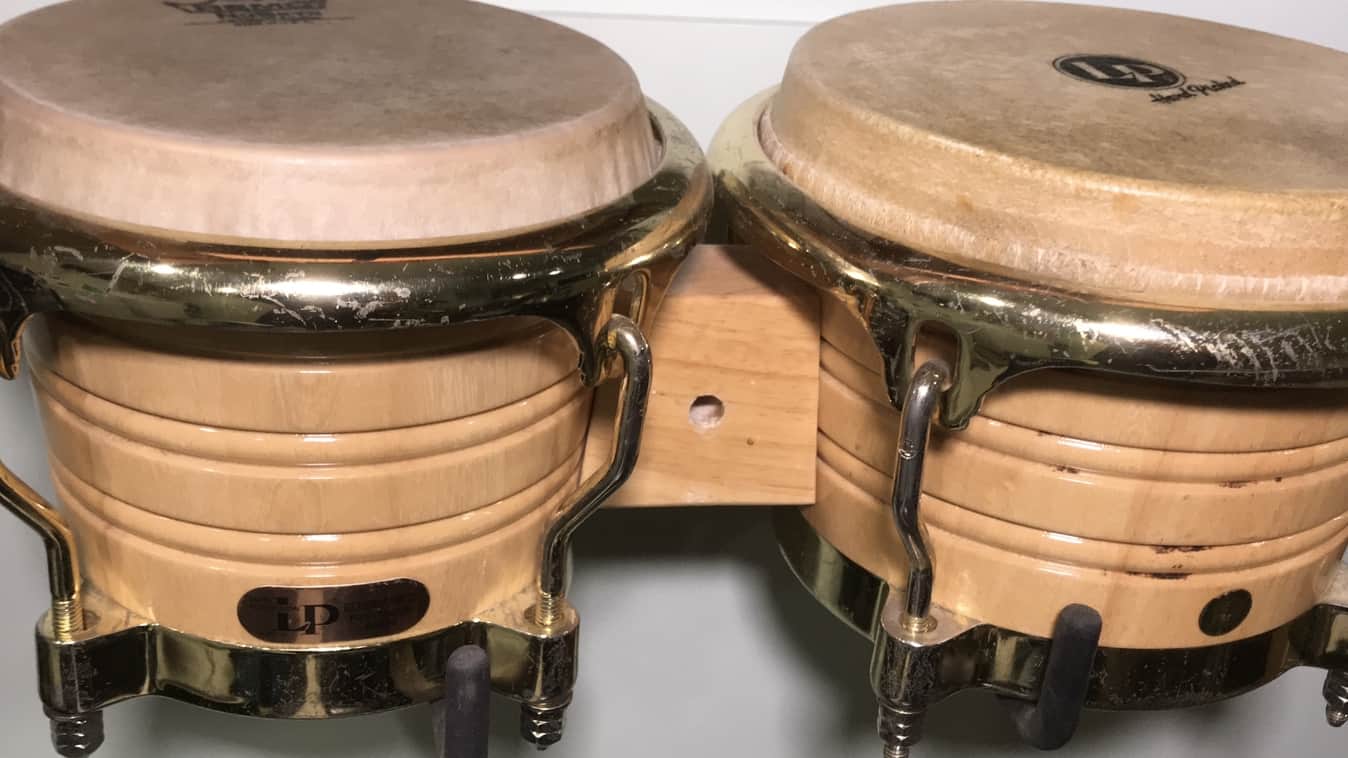“Don’t you have some bongos?” I used to hear that all the time when a full drum set was too much for the situation. This question annoyed me when I was younger, but eventually I became curious about the true nature of the instrument. Most importantly, I wondered how to play bongos in the style of its origins.
Bongo is played with the hands and fingers – mostly fingers. It’s struck with either the first finger pad or both the first and second to produce different tones. The smaller drum is higher pitched, and it’s joined to a slightly larger drum of a lower pitch. These drums are used to play parts that are highly improvisational around traditional patterns and accent phrasing, depending on the style of music.
I first learned how to play bongos in a high school Afro-Cuban music workshop. I learned just enough to get into trouble when I got to college where I accepted a few salsa gigs. It was those gigs my first semester at North Texas that set me on a path toward developing Afro-Cuban percussion technique on a variety of drums, including bongo.
What is bongo?
Bongo is an instrument comprised of two drums, a smaller drum (macho) and a larger drum (hembra). The drum is held between the legs of a seated player. The heads were originally tacked onto the shell, and heat was used to raise the pitch of the animal skin heads. In the 1940s, metal hardware was used to clamp down the heads for tuning.
These days, drums come in sizes ranging from 5” to about 8.5” – 7 1/4” and 8 5/8”, for example. Although the drums usually come with real skins, many players use synthetic heads, like the Remo Nuskyn. The use of synthetic heads in Cuba started with drummers using old x-ray film for a drum head that could withstand the tension and the changing temperatures.
Are bongo drums African?
Bongo is an Afro-Cuban instrument. It is often used as an improvisation accompaniment in jazz settings, salsa, and even poetry readings. But the origins of bongo go back to Cuba in the late 19th Century when the instrument was a part of a new music – son cubano. Prior to son cubano, bongo was used in changüí ensembles.
The instrument came from West African drum designs brought to Cuba through the Transatlantic Slave Trade. Many West African religious and secular dance-drum ensembles had drums that were paired either for lead drum calls and improvisation or for conversations performed by one player among several other drums and parts.
When Africans were stripped of their material possessions and brought to places like Cuba, they reinvented their traditions from the mixes of African traditions among them. Add Spanish music influence to this mix, and you have the beginnings of Afro-Cuban music, a dominant form in the world of Latin music.
How do you hold the bongos?
Place the bongo in between your legs while sitting on a drum throne or chair. Adjust your feet by moving them more together to cradle the drum without having to squeeze so much with your knees.
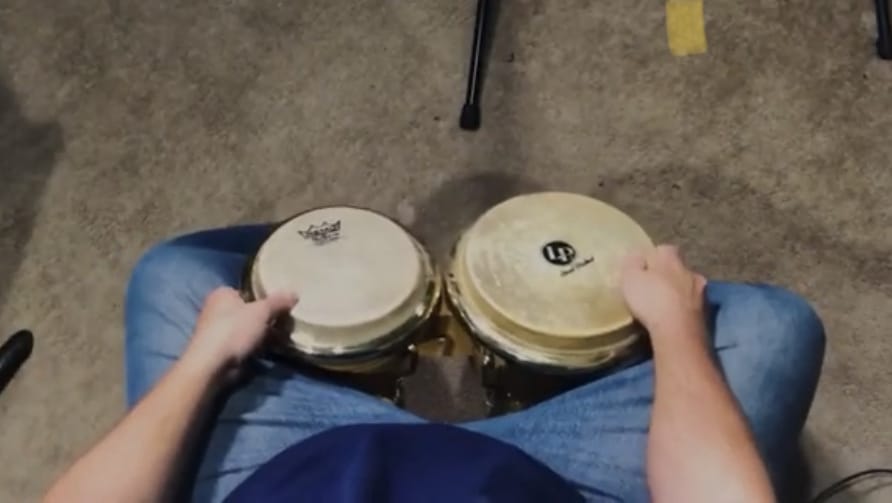
The height of your chair is important. If you’re too high or low, it could be bad for your posture and make your legs strain too much to cradle the bongos. I like to use a drum throne because the height is adjustable to exactly where I need it to be comfortable.
Some bongo players use a stand while seated or standing. You can buy stands that will go low enough for seated players, which can be nice if you have to change instruments a lot during a performance.
What’s the best technique to Play Bongos?
For the best results, use the pads of your fingers to play bongos. You can achieve different sounds when you use one pad or two. Strike the head at the edge of the drum with one or more fingers at once.
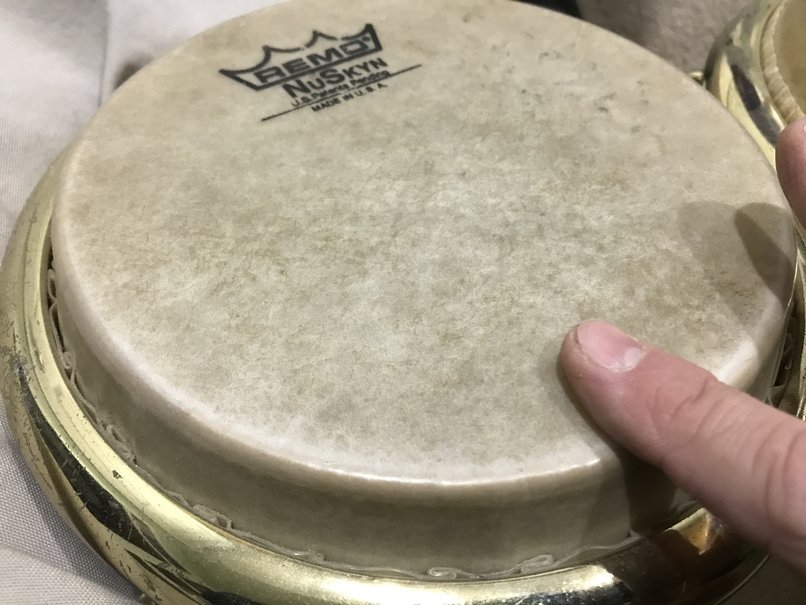
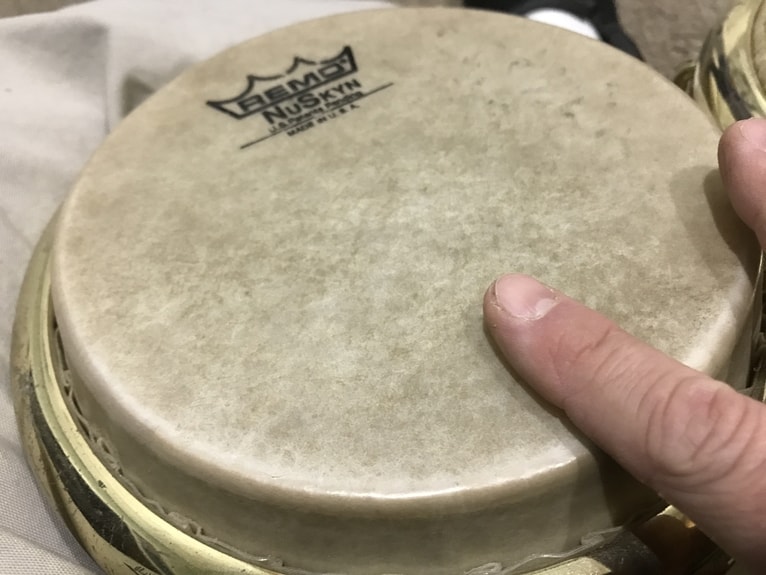
Each set of bongo and heads can be more or less effective with different techniques. You need to try different areas to play bongos and you’ll find the sweet spot.
For example, I have a synthetic head on my macho and a real skin on my hembra. I play the macho with one and two finger pads with one finger at a time, while the hembra sounds better with three pads on my index finger or three fingers.
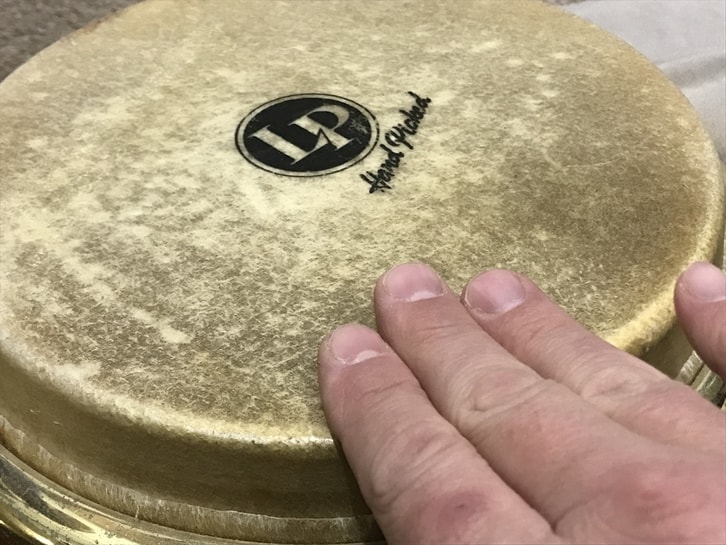
If you leave you finger on the drum, it can make a muted tone. This sound may be good for added thickness to a groove without losing the melodic elements of the open tones on both drums. For some grooves, a heel and toe technique is used to thicken the pattern (see photos below).
How to Play Patterns on Bongos
Martillo is the most common bongo pattern. Most of the Afro-Cuban styles that incorporate bongo into the ensemble use some form of martillo as the standard pattern.


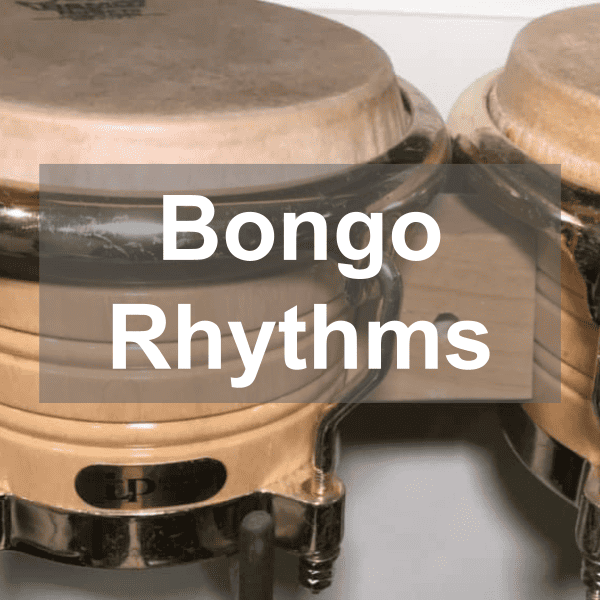
21 Rhythms to Expand Your Playing
Buy on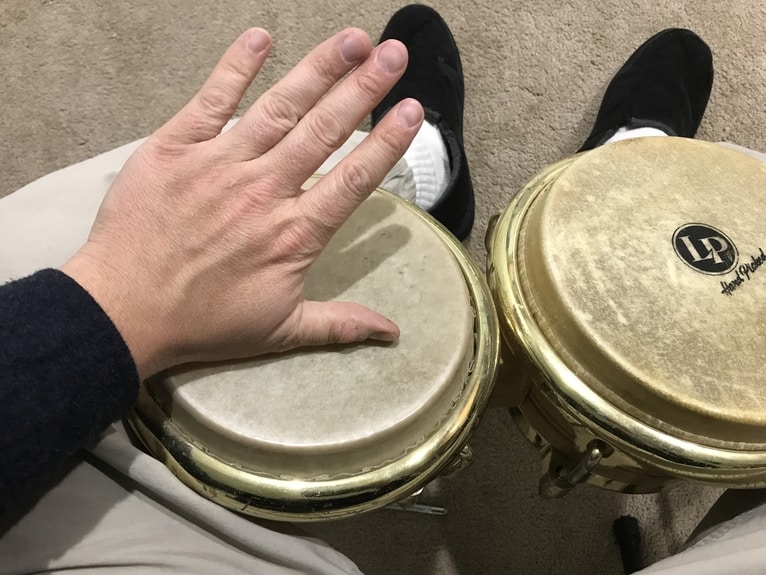
If the player is right handed, the left hand is planted on the macho with the thumb across the head to mute the head for the first strike with the pads of the right hand. The middle and ring fingers are played as muted strokes in between the downbeat tones played by the right hand.
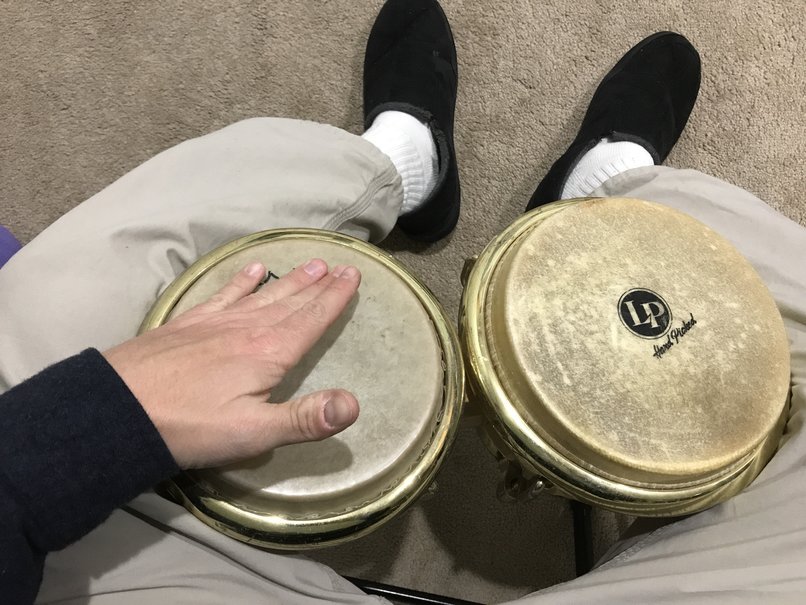
Salsa bongo patterns are highly improvisational around a particular accent pattern. Try playing martillo with these accents incorporated. Then, add fills as you transition from martillo pattern to the accents. Extend your improvisation in ways that work with the melody and lead into the accent phrasing, too.

Most importantly, listen to great bongoceros. Analyze how they phrase with martillo and conversational accent patterns, especially how it all relates to clave.
For more information on clave, check out this article.
How to Play Other Genres on Bongos
A wide range of musical styles use bongo as both a support and feature rhythm section instrument. From R&B to funk and folk rock, bongo has been pleasing listeners for decades in the popular music world.
Pop Rock Examples




What’s the best bongo set?
The best bongo is the one you have. Sometimes we have a budget for the best gear on the market, while other times we have to make do with whatever we can afford. I don’t believe that the quality of the instrument should be an excuse, but you’ll want to buy the best drum possible.
Here’s a few of the best recommendations. Click here for purchase information.
Best Bongo for The Price
The LP M201 Matador Wood Bongos are the best quality for the money you’ll spend.
The construction will last forever if the instrument is treated fairly. These drums sound good with the real skins that they come with or with synthetic replacement heads (see below for more info on synthetic heads).
The Best Bongo Set
The Giovanni Galaxy Series Bongos are the best you can buy.
The quality of the wood and the strength of the design are second to none. If you can’t sound good on these drums, you won’t sound good on anything.
Featured on Rhythm Notes
I play LP Generation II bongo with comfort curve rims.
The set matches my LP Salsa Congas, and I’ve enjoyed them on many gigs and sessions for almost 20 years with no sign of wear. They will likely last forever with proper care and love.
Other Brands
Although I own Latin Percussion congas and bongo, but it’s not the only great brand for Afro-Cuban hand drums. Meinl makes equally amazing drums. For example, the Meinl Free Ride Series Woodcraft is comparable to the LP Giovanni Series, and the 30th Anniversary Edition are like the LP M201 set.
How to Tune Bongo?
You can’t play bongos and expect to sound good without tuning the drums. The best interval between the two drums is usually around an octave or a fifth, but I don’t spend too much time on the specific pitches.
Tune each drum to achieve the best tone that the drum and head will produce. Then, make adjustments to the interval if it’s unpleasing – perhaps it’s too dissonant or just sounds strange.
Each of the four tension rods have nuts on the bottom of the drum. Turn the nuts about a half to a quarter turn each to tension the head evenly. Periodically, tap the head near each tension rod to compare the pitches. The tone of the drum will be full and more pleasing if the pitches near each rod are close to one another.
If you use real skins, you’ll want to detune the heads for transport and tune them up for performance. Otherwise, the head can be compromised as it over tightens through temperature and moisture changes. The uncontrolled tightening can also place unwanted stress on the shell of the drum.
What are the best bongo heads?
The Remo synthetic heads are excellent. They are easier to maintain because they don’t change as much, if at all, with the differences in temperature and moisture. The synthetic heads are sometimes more durable and often cut through loud bands better than the real skins.
For more information on purchasing bongo heads, this page includes a list of common sizes from the best brands.
I use a Nuskyn on my macho, but there are several heads to choose from. You could try the Skyndeep drum heads by Remo. These heads have the Crimplock technology that contains the edge of the skin.
You could also try the Fiberskyn bongo heads. These heads are designed like the real skins with the membrane wrapping around a flesh hoop (kit.co).
Make sure you get the right size head for your drums. The sizes range from 6” to sometimes 9”. The most important thing is to confirm the size you are purchasing.
Final Thoughts
Protect your fingers. Play with accuracy because you will hurt yourself on this instrument. To get the good sounds, especially with a larger band, you may get excited and hit the drums harder than you should.
If you miss a pad on your finger and slam the inside of your knuckle, you’ll surely know it the next day. Plus, when you play bongos for extended time, it may require bandages or tape to keep your skin in healthy condition.
Moisturizer goes a long way to avoid cracking and eventual bleeding. Sounds gross, but it’s part of playing hand drums – taking care of your hands.
